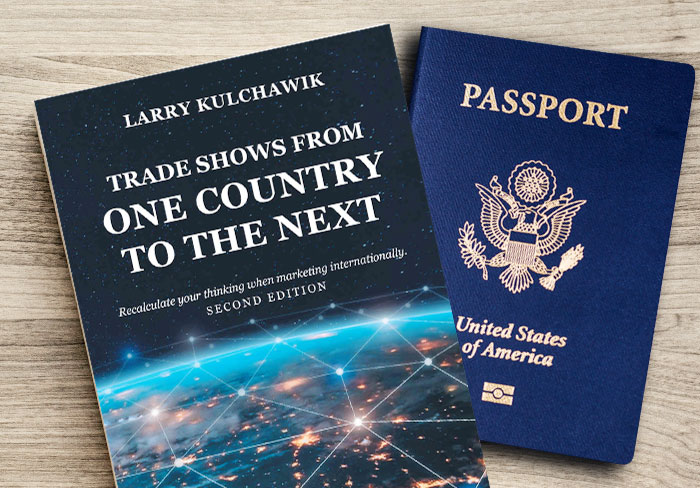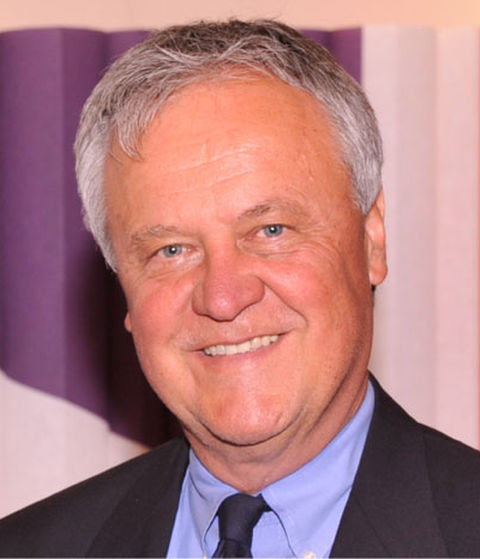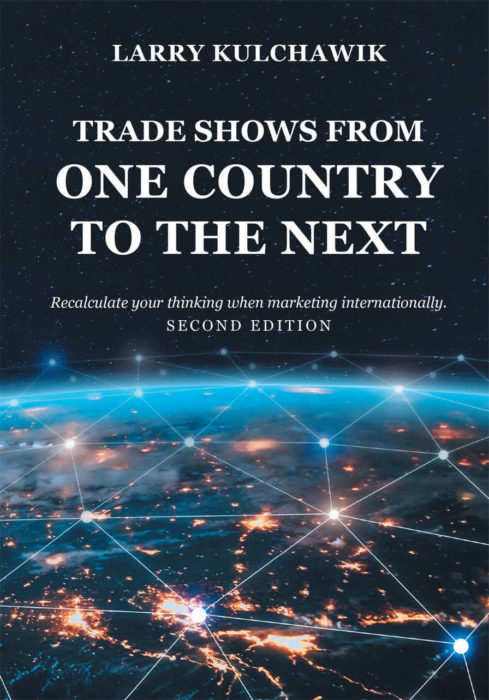
Motif Interviews Larry Kulchawik, International Trade Show Expert & Author
We had the chance to sit down with International Trade Show expert Larry Kulchawik and ask him some of the questions we thought you’d like to ask if you had the opportunity. His insight is invaluable and his book “Trade Shows from One Country to the Next” (now in its second edition) is the go-to resource for managing international events. His book is available on Amazon.com.

Larry Kulchawik
About Larry
Larry Kulchawik has spent his entire career in the exhibit industry for the past 43 years. He has worked for three of the leading exhibit companies in the USA in management and sales with a focus on international trade show marketing. He served on the boards of many industry associations (CEIR, OSPI, WTC) and as president for IFES (International Federation of Exposition Services) and EDPA (Exhibit Designer and Producers Association). As president of EDPA, he assisted in launching the first master’s degree program in exhibit design at FIT and led a task force to create UL2301- Standards for Safety when building trade show exhibits with Underwriters Laboratory. He has been awarded two of the industry’s highest honors — the Hazel Hays Award (EDPA), and the Roger Taurant Award (IFES) for his contributions to the exhibit industry.
Q: Before we get started, I think it will be helpful for people to learn a little bit about you and your background. Tell us how you got into this industry.
Larry: In 1970, I went to Southern University, and I studied design and architecture. I studied under Buckminster Fuller. I don’t know if you are familiar with him, but Google him! He was a pretty innovative and forward thinker. At the time, I was dating a girl who was working for an exhibit company in Chicago, and I got a job designing exhibits. It stuck. It’s one of those things I often tell people in our business — none of us intended to be doing what we're doing. None of us went to school to be trained for this. I think that’s an important point. Most of us have not been trained in the business. We maybe have a degree in marketing, business, or something similar that we've applied to Trade Show Marketing. My mother used to always say to me, “When are you going to be an architect?” (because of my degree), and I'd say to my mom, “I am an architect. It’s just that I take my houses down, put them back up, and use them twice.”
Q: What inspired you to write your book “Trade Shows: From One Country to the Next?”
Larry: I was president of EDPA and the first and only American President of IFES. This allowed me to get experience doing international work and meeting people all over the world. So, after 12 years of that experience, I realized the knowledge that each of these people from different countries had. When I decided to write a book, I called each and every one of them, and they all responded instantly! It was amazing.
I basically asked them all the same 12 questions. Things like: How should I act when I am in your country? What are your rules and regulations? How do you design differently for your shows?
I collected information from 45 countries and started putting it into my own words from an American point of view. Nobody is the expert everywhere in the world. I’m the first to say that I’m not. But the people that I know are the experts for their countries. You have to trust people to tell you what is fair and what’s right for doing business in their country.
When I presented the book at Northeastern Illinois University, I was quick to point out that there are six countries in the world that make up 65% of all trade show activity. Six! One of the students raised her hand and said, “Larry, if there are only six countries that do all the work at trade shows, why did you write a book about 45 countries?” Good question! You really want to be the expert in those six first. But as time goes on, we’re going to find ourselves doing business in countries that we didn’t before. You'll want to be ahead of the curve in understanding that country, their rules and regulations. This is what the book is about; helping you jump start your first show in a country that you’re not as familiar with.
Q: For someone doing their first show out of the United States, what are some of the biggest differences that you see?
Larry: The most difficult country in the world to do trade shows is the United States. We have labor issues. We have this dirty word called drayage. We have cubic content. Nowhere else in the world are there as many restrictions and ways of doing things. The rest of the world doesn’t do it like this.
So, the big differences are the show regulations and the design styles of each country. Each country has a little bit of a difference in their flair. In Europe for example, there are three things you better have in your exhibit: a raised floor, a bar, and a private meeting area. Those are three things that aren’t necessarily automatic in the United States. Especially the raised floor. I argue with the Europeans all the time; “Why do you want a raised floor, it will cost you an extra $20,000?” And I have had this answer many times over; they say “Larry, the raised floor isn’t to hide electric. It isn’t for any other reason than that it is a stage into my space. It’s a psychological barrier for entering your space. So, they are willing to pay $20,000 more because in their mind that raised floor means you are coming into my kingdom. Step up!"
A bar or cafe is the second must-have. It’s a place where you come in for a cup of coffee. And, it's going to be with a glass and saucer. Not a plastic cup. Essentially, you are engaging before you begin any kind of business. In the US we jump right into “can I sell you something?” You’re selling before you’re telling. In Europe, there’s a “get to know you” first. There’s no rush into the sale.
The third must-have is a private meeting area. Privacy is important in Europe and Asia. Especially if you are coming to make a deal, you don’t want to be doing it out in the open. It’s a big difference in Europe. People come to a show prepared to buy. In the United States, money is not frequently transacted on the show floor, but in Europe it is.
Lastly, the most important thing to understand is the country’s culture. How do I engage with a Brazilian? How do I engage with an Italian? How do I engage with a German? Especially as an American. Learn the culture of that country. How do you move your hands? How close do you stand to someone when you talk to them? What’s important to them? How do you break down their barriers? These are all things you have to know before you can start selling products and services.
Q: Put yourself in the shoes of a less experienced person tasked with managing a trade show in a foreign country. What are the biggest risks? Where are their “blind spots” likely to be?
Larry: When something works in the United States, there’s a natural impulse to say, “We’re going to do the same in Germany. We’re going to do the same in Japan.” That’s probably the biggest mistake people make. They think what works here can be translated there. That’s not true. There are cultural differences. For example, if you have a game activity or a live presenter, they don’t go over the same way there as they do here. You don’t need to abandon everything that worked in the US, but you should work to understand how to apply it appropriately in “the Japanese way” or “the Brazilian way.” It's ideal to have a partner with experience that can advise you. “Newbies” should trust their supplier/partner to help them see the blind spots and avoid the pitfalls.
Q: Do you think there is anything different about thinking through strategies and determining goals for an international event?
Larry: Each show should have a “what do we hope to achieve?” Maybe you have a product that you need to launch. The goals could be about the number of people you need to touch that have the influence to buy that product. The customer really needs to help determine these goals. It’s not something the exhibit supplier typically does — though the best ones can help a client think through them. Setting a strategy will be different for each region of the world. And, a partner can really help you in that regard. You have to trust that partner that says, “You know, people won’t want to do that.” You need to hear that.
Q: So much of successful trade show execution is about managing logistics. What is different about logistics in North America versus the rest of the world?
Larry: Let’s start with freight. You don’t need to ship everything from the US. You can get a lot of it at your location, but there may be key components — like sales literature or your product — that do need to be shipped there. Work with an experienced partner for international freight issues. Remember that the United States is the only country that uses feet and inches. Everybody else is metric. As far as the rules and regulations, trust your partner. Ask them to advise you accordingly.
Q: Can you contrast the different regions?
Larry: The biggest differences are between the US and Europe. Asia is pretty much a mix between the two except for drayage. In Europe and Asia, when you buy a space, they are not necessarily in 10' x 10' increments. They can be odd shapes. It could be a triangle. It could be a rectangle. It could be an odd shape in meters. You’re designing to fit that shape. Whereas in the United States, things are a bit more standard.
Q: In the United States we are all notorious for pushing timelines. Not because we are procrastinators, but because we expect that we can do things at the last minute and it will work out. Do you think that is a trap that people will fall into when managing international shows? Are the timelines different when you are working outside of the US?
Larry: In Europe, there is no way you can have that many last-minute things shipped. And, part of that is because they don’t set up exhibits for a preview in advance. They will if you pay, but it's not cheap. It’s not a natural part of their preparation for a show. I think in the United States we've gotten — I shouldn’t say sloppy — but a little too confident. If we don't plan for it, we count on the fact that we'll just figure it out later. Whereas, in Europe, they think through it. They are prepared for the contingency plan in advance.
Q: What about budgeting? In the US people usually know to put a few dollars aside for things that come up on site or for post-show charges. From your experience with international events, are there budgeting issues that are different?
Larry: The biggest variable is drayage. As much as we try our best to guess what the weight is, there is always someone throwing in a palette of literature that you didn’t expect. In the US, we want to charge for what’s right. Vendors can say, "Your freight didn’t arrive on time. Therefore, my guys had to work overtime." We do this all the time. We justify our invoices with "it wasn’t my fault" kinds of explanations. But you can't in Europe. It’s all one price. It’s not a question of who’s at fault. It’s "we’ve agreed on a price and that’s it." That can be a hard pill to swallow.
Q: What do you think makes for a great vendor or partner for managing an international presence?
Larry: Bad vendors have their salesperson sell the exhibit, but they don’t go to the show to see it through. Shame on them. Having that partner that truly demonstrates their passion and their dependability is really important. It’s all about service. The idea that we are getting more for our buck. The price isn’t the issue. It’s the service. Believe me. Yes, it costs more money if they send a carpenter there for the entire show. But, you want a partner who can and will do that. It’s an insurance policy that can make all the difference. So, that’s my best advice for choosing a partner to help you with an international project: Find that company that will service the hell out of it for you.


